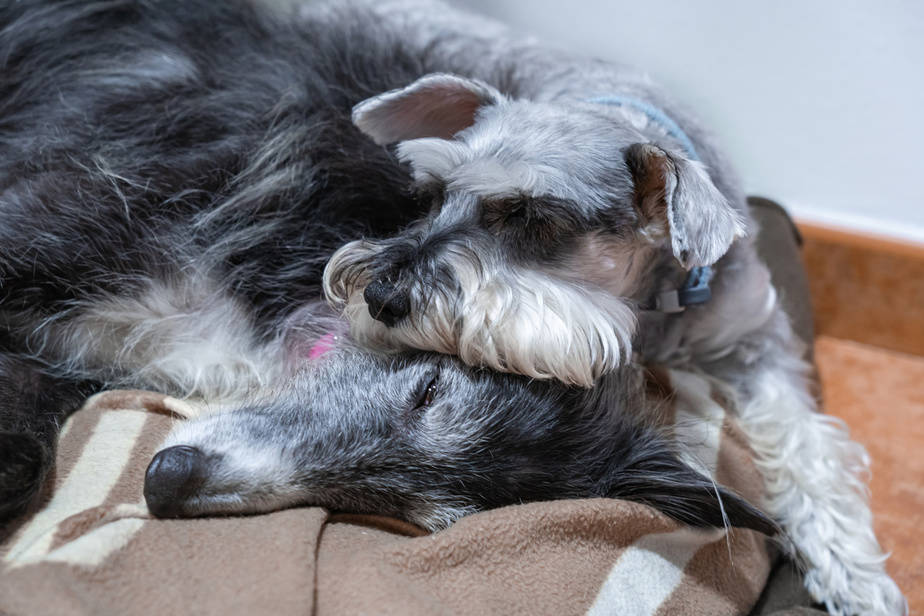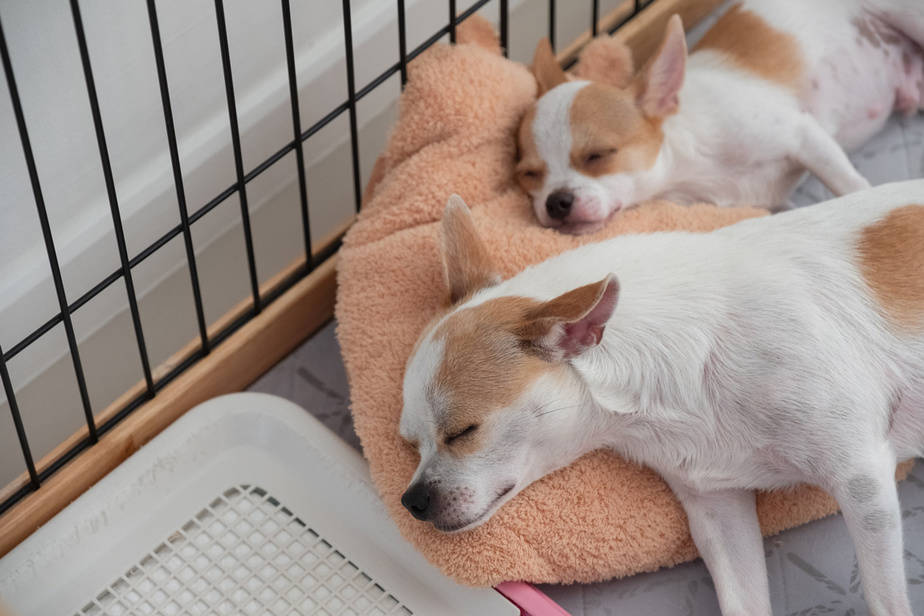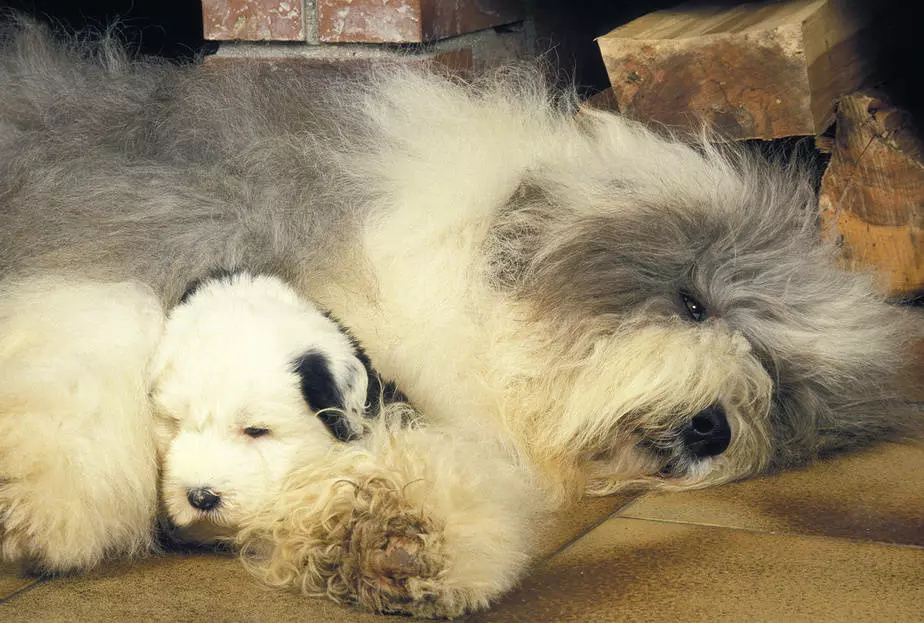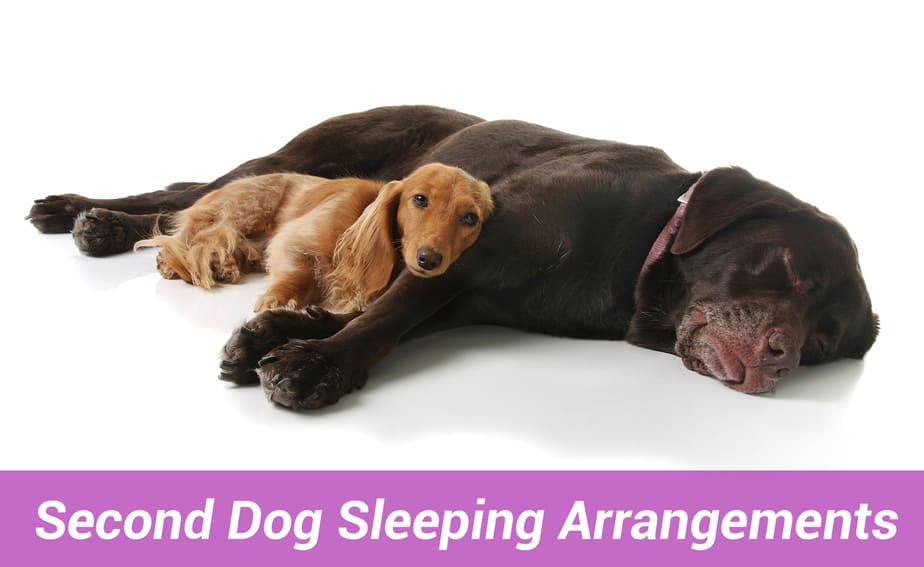So, you’ve decided to add a second dog to the house. One thing to consider is where will this new addition to your family sleep?
Once you have decided to add a new dog to your family, you should create a game plan to help your current dog feel comfortable about having another dog around.
One of the most important things to consider is where your new dog will sleep, especially in relation to your current dog.
Dogs find comfort in routine, so you want to do your best to keep your older dog as close to their current regimen as possible. And at first you will want to always monitor the dogs together, while they are getting to know each other.
So what is the best solution for sleeping arrangements?

Can my new puppy sleep with my other dog?
No, a new puppy should be kept separate during sleep from an established dog. A relationship between a new puppy and a dog will likely strengthen over time. Once their bond has formed then sleeping arrangements can be reconsidered.
Some things to consider:
- Young puppies need sleep for proper physical and mental development. But if their new friend is around at night they may not want to sleep as they can be easily distracted.
- All interactions between your two dogs should be supervised for at least a week (or even more as your puppy’s comfort level and confidence changes).
This will ensure no problems start and then escalate. If your new puppy is waking up your older dog and this causes an altercation, you will likely be sleeping yourself and won’t be able to intervene.
Even if you think your dogs will never have issues, play can quickly escalate. Puppies are mouthy, especially when playing. And if they don’t understand your older dog’s signals to back off there can be trouble.
On the flip side, if your dog is used to playing with older dogs, they may not understand that they should be gentler with a puppy.
Monitoring their time together is a key component to building a great relationship between your dogs.
So when it comes to your puppy’s sleeping area, it’s best to set them up with their own bed in their own space.
You might also like to read Was Getting a Second Dog a Mistake?
Can you crate a puppy with another dog?
No. When a dog can’t separate themselves from a situation they no longer want to be in, an undesirable outcome can occur. It’s also important that a dog learns to be comfortable alone in a crate, as removing a sleeping buddy may cause separation anxiety in the future.
Those are the biggest issues, but there are other reasons to consider. Like if your puppy isn’t house trained and has an accident in the crate. Not only will your other dog have to sit in the mess, but it’s also an indication your puppy has too much room to be properly housetrained in that space.
If you keep the crate doors open during the day, your dogs may choose to curl up together from time to time. And that is fine, as long as both dogs seem ok with it.
If your older dog needs time away from your puppy, make sure to calmly encourage your puppy to get out. Do something fun with your pup to distract them from going back in with your dog or close the door to the crate.
A new puppy can be a handful for you, but they will also be a handful for an older dog! And giving them their own time away from the puppy is a good way to release any pressure or stress the older dog is feeling.
Be sure to read our post about introducing a new puppy to an older dog, and how it can affect the older dog’s mental health.

Sleeping arrangements for puppy and older dog
A crate, kennel, or pen is the best sleeping area for a new puppy. Not only can it help prevent house soiling accidents, but it prevents them from chewing inappropriate things and gives space to an older dog.
An advantage of all these is that they can be moved. A puppy should have their own sleeping area where people aren’t walking past, or children are playing. Puppies need a lot of sleep and will require a quiet space.
Your older dog should sleep where they have always slept. There is no need to change their sleeping routine.
It is preferable for your new puppy’s confinement space to be in your room where they can see you (and your dog should they sleep in there).
Make the area where they are sleeping cozy and warm. But also observe them for a bit to make sure they don’t chew up any bedding you have in there.
Expect that on the first night there will be some whining from your new puppy. You may be tempted to think they are lonely and would do better with your other dog but resist that temptation.
If you give your new puppy access your other dog once the puppy starts whining, your puppy thinks, “All I have to do to ask for a late night play session is to use a sharp whine.” And your puppy will see no reason to change THAT behavior.
In fact, if your puppy starts barking at your dog for attention, you might want to use a blanket to block their view of your dog. And keep our dog distracted so he or she doesn’t start barking back (That won’t be a fun game at 3AM!)
If you think your puppy might have to go outside, bring them out, but resist the urge to talk to them while doing so. Also try to leave your older dog inside, in case the dogs decide to start playing.
Most of all have patience. It will take a few nights to build a new routine. And for your new puppy everything has changed, and they don’t know why. Supplying blankets with scents from their litter and some white noise may help soothe them, too.

How to crate train a puppy with an older dog
It’s recommended that you don’t share a crate between a puppy and an older dog. To crate train a puppy, create a positive association with the crate. The easiest way to do this is by using a lot of treats and praise when they go into the crate.
Hiding treats in the crate to get the puppy going in and out while finding treasure is a great way to start. However, when you have another dog in the house, it isn’t always that easy.
The other dog may decide to grab the treats while your puppy is still trying to figure out if they want to enter the crate.
So, it’s best to do short sessions while your other dog is kept busy with something fun, perhaps in his own crate with a stuffed Kong. Or on a walk with another family member.
Then hide treats in the crate. You might want to sprinkle some right around the door (both inside and out). When your puppy steps into the crate, praise them and give them more treats.
Pretty soon your puppy will be offering to go in the crate. When they do, close the door, praise and treat, and open the door again. Gradually increase the amount of time your puppy stays in the crate.
If your older dog uses his or her crate, you can put their crates side by side. Many dogs take comfort in being able to sniff and see their dog buddy. Just be aware that if they are sleeping like this, they may wake each other during the night.
The crate is an invaluable tool in multi-dog households. Dogs can be fed in their crates to make sure they are each eating the amount that is appropriate for them, and that they aren’t stealing each other’s food.
This is also helpful when your dogs are on supplements and medication. You can be sure they are each getting what they are supposed to be getting.
It is also advisable that chew treats be given in the crates. It stops any “bone theft” which can lead to resource guarding issues amongst housemates. But it is also one more way to create a positive association with the crate. And in the case of messy chew treats, it keeps the mess off of the carpet and furniture!
One last word about crate training a new puppy with another dog in the house. People often worry that if their older dog isn’t crate trained, it isn’t fair to put a new puppy in a crate. That is a human hang-up. When crate trained properly, your new puppy can learn to love a crate, regardless of where your other dog is sleeping.
Final Word
In conclusion, allowing the dogs to sleep separately will help prevent issues that could damage the dogs’ relationship.
It will also help your dog learn how to be independent of each other, which will reduce the chance of stress happening when they are apart.
As their relationship develops you may find that they will eventually choose to sleep together, or even on top of one another! But in the meantime, you will have a better idea about how they will interact while spending time together.




